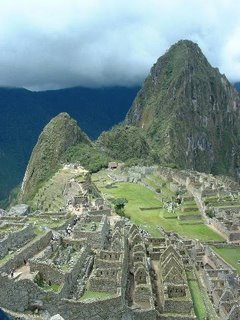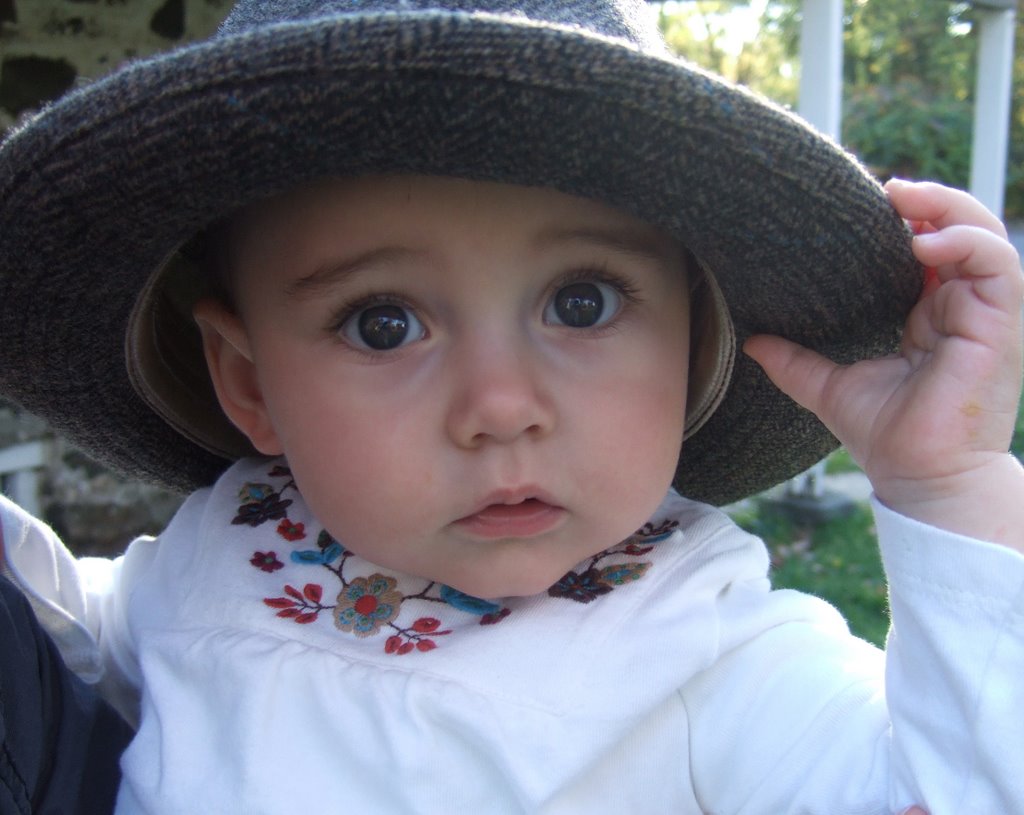Cuzco, Inca Trail, Machu Picchu, and the Sacred Valley

Wow!
Cuzco, the Inca Trail, Machu Picchu and the Sacred Valley...
These are the places that we have been hearing about throughout our travels, and have studied since we were little. How appropriately thankful we are to have finally visited these wonders, over the Thanksgiving weekend.
We began with Cuzco, a travelers mecca, and perhaps the most touristy city we have visited in the past 11 months. I think that both Dan and I were prepared to be turned off by this city and its hoards of hawkers, vendors, tourist traps and gringos, but we couldn't help but be impressed by this truly beautiful destination. Cuzco is the prettiest small city that we have visited. The center of town,gracefully, manicured Plaza de Armas, is surrounded by well-restored colonial buildings with elaborately carved wooden balconies, numerous churches filled with golden treasures and fine Cuzceña artwork, narrow cobble-stoned streets, and masterful stone Inca walls. There is so much to see! In addition to visiting all the museums and ruins that we can stand, we have taken advantage of all the western eateries. For those that have visited Cuzco, I'm sure you can remember the stylish bars like Los Perros, Fallen Angel, Paddy O'Flaherty's Irish Pub, and great restaurants like Greens - yum. Sacsaywaman was one of the most impressive ruin sights. The remaining zigzagging walls / fortifications consist of monolithic stones that are finely pieced together, fitting like a jigsaw puzzle without the help of mortar. One stone is 28 ft. high and 140 metric tons! There is no concrete explanation to how the Incas were actually able to move, cut and assemble such stone temples.
There are some drawbacks to visiting such a popular place like Cuzco. Everyday we have to fend off postcard salesmen (actually young boys), avoid the competing jaladores who flag you down with menus and flyers, practically dragging you into their restaurants, internet cafes, bars, etc., say 'no' to women and children dressed in traditional garb who want to pose for photos in exchange for soles (money), and be prepared to tip traveling bands of Andean musicians who nightly circuit the restaurants. One night, Dan and I were headed out for dinner when we passed a gang of young men. One of the Peruvians in a leather jacket, smiled, looked us in the eyes and said, "Yanquis de mierda!". This means shitty yankees. I'm sure that any white tourist could have been called the same, as we were not wearing our American flag shawls at the time. Anyhow, this was a disturbing reminder of widespread hate for Americans. Something we have sadly become accustomed to, and something that adds to our shame about our government and its foreign policy. Later that same night, we were sitting in Greens, a slightly upscale restaurant frequented by tourists and expats, when we watched a group of young Peruvian boys gather at the window and flip off everyone in the establishment. First, the Spaniards invaded Cuzco and destroyed the rich civilization of the Incas, and now Westerners come and set-up their expensive bars, hostals, exclusive restaurants, and tour companies, elbowing out the average Peruvian businessman. We can understand the underlying hate felt by many locals toward the invasion of rich foreigners, but it doesn't take the sting away.
------------------------------

On Tuesday, November 26th, we left on a 4-day trek to Machu Picchu. We booked our adventure with Andean Life (trying to decide on which company to go with is a study in minute differences). The Inca trail is seen by some as a sort of spiritual pilgrimage to Machu Picchu. Along the way, you pass several ancient ruins, such as cascading baths, which might have been places to 'cleanse' ones' spirit. There are several theories as to the purpose of these different complexes. Some people believe that these were strategic forts, lookout towers, pit stops for travelers, trading markets for food and supplies between the jungle, the sacred agricultural valley, and Cuzco, academic or theological schools, astronomical observatories, royal palaces, religious temples, or simple agricultural villages. Most likely, all of the above apply. It took us 4 days to reach the most spectacular and breathtaking sight of Machu Picchu. Along the way, we passed through varied vegetation, such as cultivated agricultural terraces and tiny Andean villages, polylepis woodlands, cloud forests, grassy antiplano, high mountain passes (4200 meters) with vistas of mammoth mountain ranges, deep canyon-like valleys, high altitude lakes and views of the Urubamba river, waterfalls, and jungles dotted with miniature orchids. Our hiking conditions varied from hot afternoons with beautiful blue skies and puffy clouds, to cool mist or hard rain with thunder. We sampled locally brewed chicha (a fermented maize beer), and chewed lots of coca to combat the effects of high altitude trekking. The trail is full of various medicinal plants, bright flowers, green and black hummingbirds, llamas, and the occasional deer spotting. This was the most luxurious 'camping' trip I have ever taken. There were 10 of us in our group (a french couple living in New Jersey, a Belgian couple, a Columbian woman living in Miami, with her twin brother from Bogota, and a Moroccan woman with her Texan boyfriend), plus an excellent Peruvian guide, Freddy, our cook extraordinaire, Genaro, and 11 porters to carry all of our food and tents. Dan spoiled me by carrying all of our clothes, sleeping bags and mats, while I got away with a small daypack full of toiletries (still heavy!). We'd hike for several hours only to arrive at a scenic rest stop with pitched dining tent, hot tea and snacks waiting for us. At the end of a strenuous day, we'd show up at our campsite with readied private tents, small buckets to wash our hands in, and a hot filling meal, minutes from being served.
The Inca trail is no easy task. Most of the path is up and down on a rocky base. On Day 2 we climbed straight up a valley to our highest pass, and it took approximately 5 hours. From there, we had to hike down a series of steep steps for another hour. This may give your lungs a break, but it is grueling on your knees. The original Inca trail winds around the sides of mountains, is narrow, uneven, passes through carved tunnels, and consists of hundreds of steps. 2 days later, and the muscles in my legs are still as tight as a taut drum. I see stairs and I start to curse.
The morning we arrived In Machu Picchu, it was drizzling and the entire complex was hidden behind a thick cloud of fog. You could sense the depression of our entire group, as we were feeling pretty sorry for ourselves and the bad luck we had with weather. After depositing our backpacks and gathering for a two hour guide around the ruins of Machu Picchu, the fog slowly began to fade. 2 hours later, and the clouds cleared to reveal blue skies, and a ring of thrusting mountains surrounding Cerro Machu Picchu. The sun was shining and the grass and surrounding jungle were a vibrant green. Dan, the uberhiker, was climbing Huayna Picchu to get a birdseye view of the ruins, and arrived to the summit just as the heavens cleared - magical. There are no words to describe the power of this place, and it is absolutely impossible to catch the beauty and essence of this wonder on photographs.
That night, Dan and I opted to stay in Aguas Calientes, where we enjoyed our first shower in 4 days -hoorah!. Pre-shower, we went to the hot thermal baths (which the city is named for). We were looking for a soothing medicinal dip, but were sadly disappointed. This time of year happens to be the period in which Peruvian school children go on group tours to learn about their heritage. We were in a murky pool full of hyper active children, screaming, splashing and dunking each other. You could see all the foreign tourists lined up against the wall of one side of the pool, trying to find escape from the creeping kids and their erratic kicks. Not relaxing - not therapeutic.
The next morning we took an early scenic train ride to Ollantaytambo, where we visited the second largest ruins, next to Machu Picchu. Here we met 3 other travelers who joined us for the day. For lunch, our guide, Freddy, had recommended Chepita restaurant in Urubamba, as the best place to try the famous national dish of Cuy. Cuy is roasted guinea pig, and it is considered a delicacy. Being cultural enthusiasts, and always up for a culinary challenge, we decided to take him up on his recommendation. When the cuy finally arrived (it took 45 minutes to prepare), the presentation brought cries of fear from our comrades. The ENTIRE intact, guinea pig - tiny teeth, dried eyes, defurred body, and clawed paws were posed on a plate of potatoes, avocado salad, and adorned with fried bananas. Somehow, the critter had been stuffed with some green minty concoction. It didn't look like we would have many takers, so Dan and I had to suck it up and take the first bite. This was not an easy thing to do, not only because one of our friends had taken the head, pierced it on a fork, and frantically waved it in front of our faces, but also because it is nearly impossible to cut off a decent bite size portion of meat, from this extremely lean animal. Watching the locals, we learned that to eat Cuy, you have to be prepared to drag your teeth across each and every little bone, in order to garner the smallest piece of flesh. You also have to like eating the skin, which is very thick, and has the occasional missed furry patch. The actual taste was not bad, but it took a lot of work and mental concentration. Needless to say, we were unable to finish our entire meal.
We continued our journey through the sacred valley (so called because it is extremely fertile), and visited Pisac. These ruins were poised high above the valley with steep terraces down the mountain side. I was the most impressed with the sun and moon temple, which displayed the finest, most symmetrical skill in rock carving. When the winter and summer solstice occurs, sunlight shines precisely through a trapezoidal window, onto a large platform with a protruding knob (carved out of natural rock) that casts a perfect shadow. This is one of many wonders that prove that the Incans had a keen knowledge of the solar system.
Back in Cuzco, we've been lying low and trying to catch up on sleep. We've finally sampled Peruvian ceviche (raw fish that is 'cooked' with lemon juice), which is very delicious! Dan bought some coca seeds so that we can start our own farm in the U.S. (ha, ha!). I'm recovering from a nasty wine hangover, but am fine and happy. Tomorrow we will fly to Lima, and catch a bus to Pisco, the Peruvian coast.
We miss you all and send our love,
Sarah and Daniel
Check out our pics at
http://www.pbase.com/dgsc/percuz and http://www.pbase.com/dgsc/permac



0 Comments:
Post a Comment
<< Home